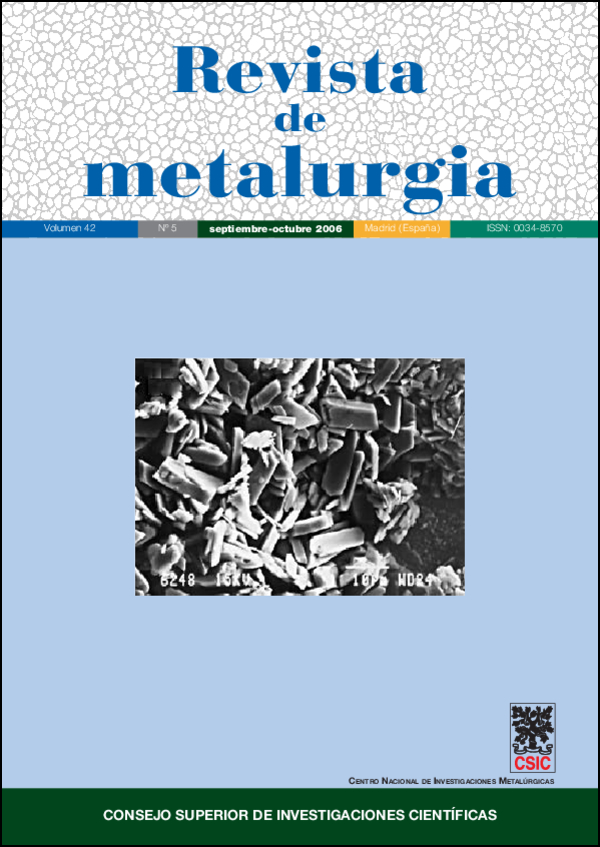Effect of milling conditions on the properties of Cu-NbC alloys obtained by powder metallurgy
DOI:
https://doi.org/10.3989/revmetalm.2006.v42.i5.30Keywords:
Strengthening of copper composite materials, Powder metallurgy, Mechanical and electrical, propertiesAbstract
Copper-base composite materials were obtained by reinforcing with homogeneous dispersions of 0.5 and 1% vol. of very fine NbC particles, through mechanical milling process in a planetary mill during 8 and 24 h at two different rotational speeds. The consolidation of the alloyed reinforced particles was achieved through a hot uniaxial pressing at 923K under 90 MPa during 2 h under a protective argon atmosphere. Factors to the suitable combination of electrical conductivity and mechanical properties attained are the hardness and good thermal stability of the niobium carbide which affords further refinement in the size of copper particles and the reinforcement of the alloy. A lower embrittlement and higher electrical conductivity of this alloy was observed, as a consequence of the smaller amount of impurities (Fe, Cr, C and O) incorporated during the lower-energy milling. Scanning and transmission electron microscopy and X-ray diffraction show an additional strengthening of the grain substructure by precipitation of nanometer-size impurities.
Downloads
References
[1] M. Hofmockel, Proc. EURO PM2004, vol. 1, Viena, Austria, 2004, pp. 231-236.
[2] V. Dovydenkov y E. Shalunov, Proc. 1998 PM World Congress, Vol 1, pp. 373-377.
[3] S.E. Broyles, K. R. Anderson, J.R. Groza, J.C. GIBELING Metall. Mater. Trans. A 27 (1996) 1.217-1.227.
[4] S. Nagarjuna y K. Balasubramanian, J. Mater. Sci. 32 (1997) 3.375-3.385
[5] M.A. Morris y D.G.Morris, Mater. Sci. Eng. A111 (1989) 115-127. doi:10.1016/0921-5093(89)90204-9
[6] K.R. Anderson, J.R.Groza, R.L. Dreshfield y D.Elis, Metall. Mater. Trans. A, 26 (1995) 2.197- 2.206.
[7] M.L. Lopez, V. Vergara, C. Camurri, J.A. Jimenez y O.Ruano, EURO PM2004, vol. 4, Viena, Austria, 2004, pp. 737-742.
[8] M. López, D. Corredor, C. Camurri, J.A. Jiménez, Mater. Characterization 55 (2005) 252- 262. doi:10.1016/j.matchar.2005.04.006
[9] D.L.Ellis y G.M.Michel, Scr. Metall. Mater. 24 (1990) 885-890. doi:10.1016/0956-716X(90)90130-9
[10] M.Lopez, C.Camurri, V.Vergara and J.A.Jimenez, Rev.Metal. Madrid 41 (2005) 308-312.
[11] R. F. Singer, W.C.Oliver Y W.D.Nix, Metall. Trans. A 11 (1980) 1.895-1.905.
[12] D. J. Lloyd, Int. Mat. Rev. 39 (1994) 1-23.
[13] J.Garcia, G.Garces, P.Perez y P.Adeva, Rev.Metal. Madrid 41(2005) 286-291.
[14] R. Palma y A. Sepulveda, J. Mater. Sci. Forum 416-418 (2003) 162-167.
[15] R.J. Arsenauld y N. Shi, Mater. Sci. Eng. A 81 (1986) 175-187. doi:10.1016/0025-5416(86)90261-2
[16] I.E. Anderson y J.C. Foley, Surf. Interface Anal. 31 (2001) 599-608. doi:10.1002/sia.1087
[17] T.J. Doel y P.Bowen, Composites A 27 (1996) 655-665. doi:10.1016/1359-835X(96)00040-1
[18] S.W.Miller y F.J.Humphreys, Scr. Metall. Mater. 25 (1991) 33-38. doi:10.1016/0956-716X(91)90349-6
Downloads
Published
How to Cite
Issue
Section
License
Copyright (c) 2006 Consejo Superior de Investigaciones Científicas (CSIC)

This work is licensed under a Creative Commons Attribution 4.0 International License.
© CSIC. Manuscripts published in both the printed and online versions of this Journal are the property of Consejo Superior de Investigaciones Científicas, and quoting this source is a requirement for any partial or full reproduction.
All contents of this electronic edition, except where otherwise noted, are distributed under a “Creative Commons Attribution 4.0 International” (CC BY 4.0) License. You may read the basic information and the legal text of the license. The indication of the CC BY 4.0 License must be expressly stated in this way when necessary.
Self-archiving in repositories, personal webpages or similar, of any version other than the published by the Editor, is not allowed.
















